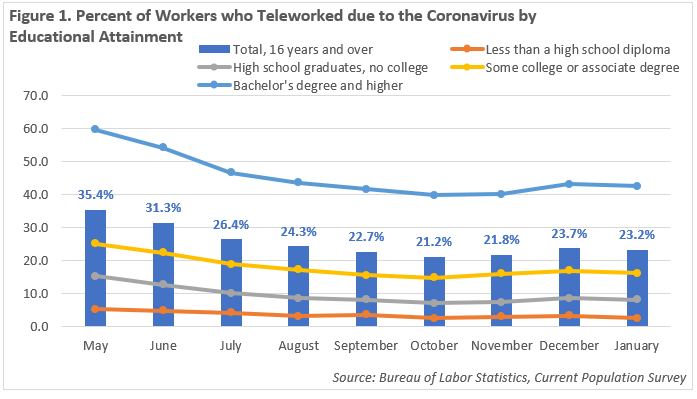
by Cameron Macht
March 2021
The world of work changed in the early days of the coronavirus pandemic, as the number of people working from home jumped to unprecedented levels. Census data estimated that about 190,000 Minnesotans were working from home in 2019, representing about 6.5% of the state's labor force. By May of 2020, over one-third of workers nationwide reported that they teleworked due to the coronavirus, which would be the equivalent of more than one million Minnesotans! More recently, estimates show that just over 600,000 workers in Minnesota were teleworking due to the coronavirus.
As the spread of the virus ebbed and flowed over the course of the summer and most organizations were able to implement safety and social distancing measures, the number and percent of workers who were teleworking steadily declined, to a low of 21% by October. However, that was still more than three times as high as prior to the pandemic, and before the percentage teleworking started ticking back upward moving into the winter, climbing back above 23% by January (see Figure 1).

While it was easier and more convenient – and even preferable – for workers in some sectors and occupations to make the transition, other industries and their front-line workers did not have the option to work from home. As shown in Figure 1, workers with lower educational attainment were less likely to be able to telework, while nearly 60% of workers with a Bachelor's degree or higher were able to work from home at one point.
This disparity makes more sense when coupled with a breakdown of the survey responses collected through the monthly Current Population Survey run by the Bureau of Labor Statistics, which shows percentages and numbers of workers by industries and occupations who were teleworking because of the coronavirus pandemic. Table 1 shows the industries that are most and least likely to still have people teleworking due to the coronavirus. Not surprisingly, industries with a higher amount of office work, such as Professional and Technical Services or Finance and Insurance have loads of people working from home; whereas industries such as Construction and Agriculture need to have most of their workers on-site.
| Industry | Percent of workers who teleworked because of the coronavirus pandemic, United States | Estimate of Minnesota workers who teleworked because of the coronavirus pandemic* |
|---|---|---|
| Professional & technical services | 53.0% | 82,187 |
| Finance & insurance | 50.4% | 74,140 |
| Information | 45.9% | 21,518 |
| Educational services | 42.6% | 91,555 |
| Public administration | 36.9% | 48,822 |
| Utilities | 29.0% | 3,876 |
| Real estate & rental & leasing | 28.8% | 9,760 |
| Wholesale trade | 20.6% | 25,736 |
| Arts, entertainment, & recreation | 19.6% | 7,511 |
| Mining, quarrying, & oil & gas extraction | 22.2% | 1,199 |
| Manufacturing | 20.1% | 62,211 |
| Health care & social assistance | 16.4% | 79,394 |
| Other services | 15.6% | 11,962 |
| Management, admin. & waste services | 16.2% | 33,389 |
| Retail trade | 9.2% | 25,085 |
| Construction | 7.8% | 10,160 |
| Transportation & warehousing | 7.6% | 7,872 |
| Agriculture & related industries | 5.1% | 1,145 |
| Accommodation & food services | 4.1% | 7,417 |
| Total, All Industries | 22.6% | 604,940 |
| Source: Bureau of Labor Statistics, Current Population Survey; * - Author's analysis of DEED Quarterly Census of Employment & Wages data | ||
At the occupation level, the jobs most likely to still have people teleworking due to coronavirus were:
In contrast, the occupational groups that were least likely to have people teleworking were:
According to survey results for January 2021, the data also show that women (26.0%) are more likely to be teleworking than men (20.8%), full-time workers (25.5%) are twice as likely to be teleworking as part-time (12.0%) workers, and by race, Asians (36.9%) and Whites (22.8%) are more likely to be teleworking than Blacks (18.8%) and Hispanic or Latinos (13.8%). Perhaps not surprisingly, people in their prime working years between 25 and 54 years of age (26.3%) were also much more likely to be teleworking than older workers (21.6%), as well as the youngest workers (9.8%).
